実施日 : 2009年03月27日(金) - 28日(土)
【Press Tour】Mar. 27-28, 2009:Press Tour to San-in Region: Shimane & Tottori
投稿日 : 2013年08月22日
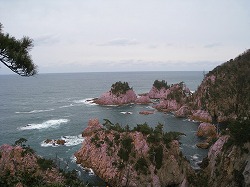 - San-in’s Nature, Culture, and Environment -
- San-in’s Nature, Culture, and Environment -
The San-in Region is in the southwest of Honshu, the main island of the Japanese archipelago. It consists of the northern part of Chugoku region, mainly Shimane and Tottori Prefectures, (broadly including Kyoto and Yamaguchi prefectures), facing the Sea of Japan.
The tour will first fly from Tokyo to Izumo (Shimane) and visit Matsue city, the capital called “water city" as it sits on Lake Shinji, as well as Adachi Museum of Art where visitors can enjoy the beauty of the art in harmony with the Japanese garden. Day one features the Shimane’s elegance, a blend of the nature and tradition.
On the following day, the tour will move from Yonago (Tottori), the San-in’s business hub, to the east along the coast line of the Sea of Japan, visiting the Tottori Sand Dunes and the San-in Shoreline which is currently aiming to be recognized as a 'Global Geopark'. The contrast between dunes/sandbars and dynamic cliffs eroded by the sea, the 'ria shoreline', is a great attraction in the Tottori program. The tour will also visit the Arid Land Research Center, Tottori University, whose mission is to combat ‘desertification’, one of the most serious problems on Earth.
***********************************************************
The San-in Region is in the southwest of Honshu, the main island of the Japanese archipelago. It consists of the northern part of Chugoku region, mainly Shimane and Tottori Prefectures, (broadly including Kyoto and Yamaguchi prefectures), facing the Sea of Japan. In particular, Shimane and Tottori are called “San-in prefectures.”
 The name ‘San-in’ means “the northern, shady (yin in Chinese) side of the mountains” and in terms of the weather it is often cloudy and rainy. Thus people always get a gloomy impression of the region. However, if you physically go there and expose yourselves to the nature, culture and tradition which have been carefully preserved and nurtured, you will be able to shrug off the negative image.
The name ‘San-in’ means “the northern, shady (yin in Chinese) side of the mountains” and in terms of the weather it is often cloudy and rainy. Thus people always get a gloomy impression of the region. However, if you physically go there and expose yourselves to the nature, culture and tradition which have been carefully preserved and nurtured, you will be able to shrug off the negative image.
The northern part of the San-in region faces the southern part of the Sea of Japan, to the south lie the Oku-izumo Mountains and the highest peak in the region, Mount Daisen (Tottori pref.), with the scenicLake Shinji (Shimane) at the center. Stretching extensively from east to west, the San-in is blessed with rich and dynamic nature and has many traditional spa areas including the Tamatsukuri (Shimane) andMisasa (Tottori) onsens.
In addition, many tales from Japanese mythology, for example, “Inaba no shiro usagi”, or the white rabbit in Inaba (the modern Tottori) and “yamata no orochi” (a tale set in Izumo, the modern Shimane. The ‘orochi’ was a big snake with eight heads and tails) are deeply rooted in the region.
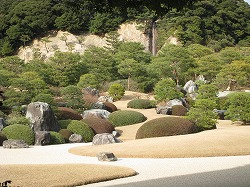
The tour will first fly from Tokyo to Izumo (Shimane) and visit Matsue city, the capital called “water city” as it sits on Lake Shinji, as well as Adachi Museum of Art where visitors can enjoy the beauty of the art in harmony with the Japanese garden. Day one features the Shimane’s elegance, a blend of the nature and tradition.
On the following day, the tour will move from Yonago (Tottori), the San-in’s business hub, to the east along the coast line of the Sea of Japan, visiting the Tottori Sand Dunes and the San-in Shoreline which is currently aiming to be recognized as a 'Global Geopark'.The contrast between dunes/sandbars and dynamic cliffs eroded by the sea, the 'ria shoreline', is a great attraction in Tottori program. The tour will also visit the Arid Land Research Center, Tottori University, whose mission is to combat ‘desertification’, one of the most serious problems on Earth.
*San-in International Tourism Conference, the host, and the Foreign Press Center co-organized this press tour.
Presentations:
■SHIMANE Prefecture
Shimane Prefecture is located in the western part of Honshu, the main island of the Japanese archipelago, in the northern part of the Chugoku region. Neighboring prefectures include Tottori prefecture to the east, Yamaguchi to the west, and Hiroshima with the Chugoku Mountains to the south. The northern part of the prefecture faces the Sea of Japan and the Oki Islands are out at sea some 40 to 80 kilometers off the northern coast of Shimane Peninsula. The prefecture’s population is as many as 720,000 as of January 2009.
Matsue, the capital, is a historical city with Matsue Castle at its center, where Lafcadio Hearn (Yakumo Koizumi), an English man of letters who took Japanese citizenship, lived from 1890 until his death in 1904. Recently the French travel book named Guide Bleu has given Matsue three stars. Another attraction is Lake Shinji in the center of the city, Japan’s 7th largest lake, 45 kilometers around and 80 square kilometers in area. The lake was inscribed as a registered wetlands under the Ramsar Convention in 2005. Likewise, Iwami Ginzan Silver Mine and its cultural landscape, located in the central part of the prefecture, were listed in the World Heritage in July 2007.
Governor Zenbe Mizoguchi’s Profile
Born in Shimane prefecture in 1946. After graduating from University of Tokyo, he joined the Ministry of Finance, became Vice Minister of Finance for International Affairs in 2003, President of the Japan Center for International Finance, then was electedGovernor in April 2007.
A wave of global economic slowdown like a tsunami is currently approaching each country, and Shimane is not an exception.“It is most critical for the prefecture to respond to the crisis” says the Governor and swiftly delivered a measure to set up a long term loan system with low interest rate for small and medium sized companies in line with the emergency economic package announced by the central government right after the crisis surfaced, and included 30 trillion yen of cash-flow support measures for small and medium-sized businesses.
He also devotes his efforts to reducing the disparity between urban and rural areas, which was widened by the economic efficiency-orientated reforms carried out by then Premier Koizumi.
●Horikawa Sightseeing Boat---result of Environment, Tourism Promotion, and Elderly employment (Matsue City)
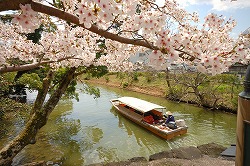 Currently commemorating the 400th anniversary of its foundation, Matsue Castle is the landmark of Matsue City and one of the twelve castles that still have their keep towers. The water of the castle moat, the Horikawa, was polluted about a decade ago.
Currently commemorating the 400th anniversary of its foundation, Matsue Castle is the landmark of Matsue City and one of the twelve castles that still have their keep towers. The water of the castle moat, the Horikawa, was polluted about a decade ago.
In April 1996, then Mayor of Matsue City, the late Mr. Miyaoka, announced that the city planned to clean up the water and operate a sightseeing boat cruise in the moat. The whole city was involved in his great clean-up drive. For infrastructure, a waterway linking Lake Shinji and the Horikawa river was built to circulate water and the swage pipes were also built to clear the sludge. The citizens also made efforts to stop littering cans and illegal waste dumping.
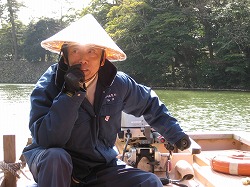
These joint efforts of the administration and citizens bore fruit, and the Horikawa Sightseeing Boat was launched on July 20, 1997. Today it attracts as many as330,000 passengers (as of 2007).
In addition, a total of 101 senior citizens including 11 women, whose average age is 63.29 years old (as of May, 2008), are currently hired and enjoy working on the boat. It is still unusual in Japan that a company hires 100 people or more and the most of its employees are elderly.
The tour participants will enjoy the Horikawa river cruise with professional senior boatmen/women and hear about the success of the project in the field of environment, tourism, and employment of the elderly.
●Adachi Museum of Art---acclaimed as the Best Japanese Garden (Yasugi City)
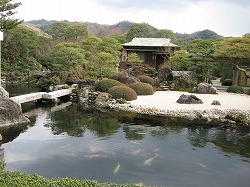 Located in Yasugi city, Shimane Prefecture, the Adachi Museum of Art is known for itscollections of modern and contemporary Japanese paintings including the works ofTaikan Yokoyama and attracts as many as 470,000 visitors a year. That is not all they come for.
Located in Yasugi city, Shimane Prefecture, the Adachi Museum of Art is known for itscollections of modern and contemporary Japanese paintings including the works ofTaikan Yokoyama and attracts as many as 470,000 visitors a year. That is not all they come for.
In fact, the museum’s true attraction is its huge Japanese garden (13,000 tsubo; l tsubo=3.954 square yards). When you stand at the gate, you will see the superbKaresansui, or dry landscape, a garden in harmony with the range of mountains behind.“The garden is, so to speak, a picture scroll; a ‘living’ painting.” Based on this brief,Adachi Zenko, the founder, dedicated his whole life to creating the ideal garden that helps visitors appreciate the exhibited works to the full.
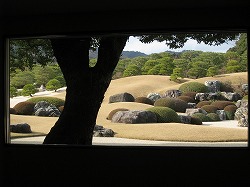 The Journal of Japanese Gardening, a gardening magazine published in the United States, selected the Adachi Museum of Art as the “Best Garden in Japan” out of 803 Japanese-style gardens for the last six years in a row, from 2003 to 08.
The Journal of Japanese Gardening, a gardening magazine published in the United States, selected the Adachi Museum of Art as the “Best Garden in Japan” out of 803 Japanese-style gardens for the last six years in a row, from 2003 to 08.
The outstanding success of this garden is largely due to an intensive grooming and maintenance program that involves every single member of the museum’s staff on a daily basis. Actually the museum employs three full-time curators but seven full-time gardeners; the difference of numbers reflects the museum’s devotion to the maintenance of the garden.
The tour will not only visit the exhibitions and gardens but also meet with Director Takanori Adachi and Head Gardener Nobuhiko Kobayashi who will demonstrate his techniques of trimming trees.
■TOTTORI Prefecture
Situated in the northeastern part of the Chugoku region, Honshu Island. The northern part of the prefecture faces the Sea of Japan, bordered by a beautiful coastline decorated with green pines and white sand, including the Tottori Sand Dunes. To the south lie the Chugoku Mountains and the greatest peak in the region, Mount Daisen. Major cities in the prefecture include Tottori City, the capital, Kurayoshi and Yonago. Its population is approx. 600,000, the smallest in Japan’s 47 prefectures.
Taking advantage of the geography, as “the western base for exchange between countries bordering the Sea of Japan”, the prefecture has been actively communicating with Gangwon province in South Korea, Jilin province in China, Primorsky Province in Russia, and Tuv Province in Mongolia. The prefecture has many liquid-crystal related firmsincluding Epson Imaging Devices Corporation and Sharp Yonaga Corporation and promotes the “Crystal Corridor Project” to become a home of the LC.
Governor Shinji Hirai’s profile
Born in 1961, Mr. Hirai graduated from University of Tokyo and joined the Ministry of Home Affairs in 1984. After serving as Vice Governor of Tottori Prefecture from 2001 to 03, he was elected Governor in April 07.
In the last two years, he has worked hard to stimulate the local economy and industry and implemented such measures as inviting private firms to the prefecture, launching a new water route across the Sea of Japan, and opening ‘Hello Work’, a job-placement office, in the prefecture, as well as Tottori’s pilot shop in Tokyo. At the beginning of this year the Governor advocated that Tottori should join the Greater Kinki Entity to play an active role as a bridge between the Chugoku and Kinki districts.
He also devotes time and energy to try to rescue the missing Japanese citizens who were abducted by North Korea. Recently he sent a letter signed by him to six sister cities/regions outside Japan and asked for their assistance in letting people in the world know about the issue.
●Japan’s most famous “Tottori Sand Dunes”: and “San-in Coast Geopark” aiming to be listed in the Global Geoparks Network (Tottori city and Iwami Town)
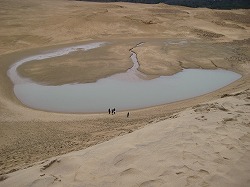 The magnificent Tottori Sand Dunes, spreading 16 kilometers from east to west and 2 kilometers from north to south, are the most popular destination for tourists in Tottori. Soon after arriving, they are impressed by the beautiful patterns on the sand created by wind, namely'Fumon', or wind ripple, and'Saren', or sand screens in a wave pattern, which keeps changing as the blows. Unlike a desert, these sand dunes have a layer of wet sand under the dry sand. In particular, as it is high-rainfall in the Tottori Sand Dunes, huge puddles develop, which look like ponds on the surface.
The magnificent Tottori Sand Dunes, spreading 16 kilometers from east to west and 2 kilometers from north to south, are the most popular destination for tourists in Tottori. Soon after arriving, they are impressed by the beautiful patterns on the sand created by wind, namely'Fumon', or wind ripple, and'Saren', or sand screens in a wave pattern, which keeps changing as the blows. Unlike a desert, these sand dunes have a layer of wet sand under the dry sand. In particular, as it is high-rainfall in the Tottori Sand Dunes, huge puddles develop, which look like ponds on the surface.
The contrast between the Tottori sand dunes and the near-by San-in shoreline which is known for its dynamic cliffs eroded by the sea, the so-called “ria shoreline”, is also an attraction. The area has a wide variety of geological features and bears testimony to the dynamic processes involved in the birth of this archipelago.
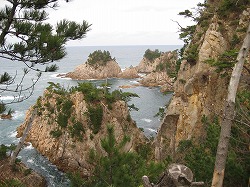 On the San-in shoreline along the Japan Sea, stretching from Tottori to Hyogo and Kyoto prefectures, rocks and strata formed by volcanic activity are visible. This activity caused what is now the Japanese archipelago to break off from the Asian continent 15 to 25 million years ago with the Japan Sea formed in the new space.
On the San-in shoreline along the Japan Sea, stretching from Tottori to Hyogo and Kyoto prefectures, rocks and strata formed by volcanic activity are visible. This activity caused what is now the Japanese archipelago to break off from the Asian continent 15 to 25 million years ago with the Japan Sea formed in the new space.
The San-in shoreline with the national park at its center was registered in “Japan Geopark Network (JGN)” in February 2009 and the related prefectures, municipalities, and local private organizations have started working together to obtain the UNESCO-supported “Global Geopark” label in future.
On the tour, we will be briefed on the Geopark Network registration and explore the Uradome shoreline, a scenic ria shorelinewith steep cliffs and caves, cruising by boat. Then we will move to the Tottori sand dunes where we can discover the beauty of the curves created naturally by the wind as well as meet with sand sculptors who will have started working for the forthcoming“World Sand Festival” in April this year.
●Arid Land Research Center, Tottori University---Combat “Desertification”, one of the most serious problems on Earth (Tottori City)
 About 41% of the land on the surface of the earth is waterless. Land degradation induced by deforestation as well as excessive agricultural and livestock activities, namely“desertification”, affects 10-20% of the arid land in the world, and its total area is 6-12 million square kilometers. Although we have neither dehydrated land nor a desertification problem in Japan, the Japanese Government ratified the UNCCD: United Nations Convention to Combat Desertification in 1998.
About 41% of the land on the surface of the earth is waterless. Land degradation induced by deforestation as well as excessive agricultural and livestock activities, namely“desertification”, affects 10-20% of the arid land in the world, and its total area is 6-12 million square kilometers. Although we have neither dehydrated land nor a desertification problem in Japan, the Japanese Government ratified the UNCCD: United Nations Convention to Combat Desertification in 1998.
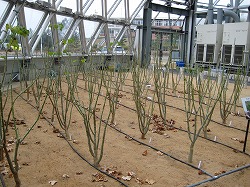 The Arid Land Research Center (ALRC), established in 1990, devotes its efforts to academic research to help stop the desertification of drylands and promote sustainable development across the world. The center and its predecessor have a combined 80 years of expertise and technology in plant growing and revegetation of sandy soil. It has an international partnership with United Nations University (UNU) as well as the China Academy of Science (CAS) in the fields of education research and human resource management, and is currently carrying out various projects in China, Mongolia, and Africa. Recently, in the collaboration with a recycling firm in Tottori, it discovered a soil-improving agent made from scrap glass that cuts down on watering needs for sandy soil.
The Arid Land Research Center (ALRC), established in 1990, devotes its efforts to academic research to help stop the desertification of drylands and promote sustainable development across the world. The center and its predecessor have a combined 80 years of expertise and technology in plant growing and revegetation of sandy soil. It has an international partnership with United Nations University (UNU) as well as the China Academy of Science (CAS) in the fields of education research and human resource management, and is currently carrying out various projects in China, Mongolia, and Africa. Recently, in the collaboration with a recycling firm in Tottori, it discovered a soil-improving agent made from scrap glass that cuts down on watering needs for sandy soil.
The tour will visit the ALRC, located in front of Tottori Sand Dunes, where we will hear about their on-going projects from Mr. Atsushi Tsunekawa, Director/Professor, and then inspect the Arid Land Dome, a dome-shaped glass greenhouse which has an environmental control system to simulate the climate of arid regions.
Tour itinerary and application details:
1.Itinerary (Tentative):
[DAY 1: Friday, March 27]
07:30 Meet at Tokyo Haneda Airport
08:15 Leave Haneda Airport by JAL Flight 1663
09:45 Arrive at Izumo Airport
10:10 Leave Izumo Airport
(move by chartered bus to Matsue)
-Briefing on Shimane Prefecture
-Briefing on the efforts of Horikawa Pleasure Boat
Company in environmental protection, tourism promotion,
and elderly employment
11:00-11:50 Cruise by the Horikawa Sightseeing Boat and around Matsue’s scenic castle district
12:00-13:00 Lunch at “Teien Saryou” a Japanese restaurant at Matsue Minamikan, an old ryokan
13:15-13:45 Take a walk around Matsue Castle
14:00-14:30 Meet with Zenbe Mizoguchi, Governor of Shimane Prefecture
15:15-17:00 Visit Adachi Museum of Art
-Tour at the museum
-Meeting with Director Takanori Adachi
-Demonstration of gardening by Chief Gardener Nobuhiko
Kobayashi
17:30 Check in at ANA Hotel Yonago
18:30-20:00 Dinner hosted by San-in International Tourism Conference
[DAY 2:Saturday, March 28]
08:00 Leave hotel for San-in Coast by chartered bus
-Briefing on Tottori Prefecture
-Briefing on San-in Coast Geopark project by an expert
10:30 Visit San-in Coast National Park
11:30-12:10 Cruise by the boat around Uradome beach and islands
12:15-13:15 Lunch meeting with Mr. Shinji Hirai, Governor of Tottori Prefecture(@Kadowaki-chaya)
13:30-14:30 Visit Arid Land Research Center,
Tottori University
-Briefing by Mr. Atsushi Tsunekawa, Director/Professor
-Inspection tour at Arid Dome
14:45-16:20 Explore Tottori Sand Dunes
-Meeting with sand sculptors
17:00 Arrive at Tottori Airport
17:40 Leave Tottori Airport by ANA Flight 298
18:55 Arrive at Haneda Airport
2. Qualification: Bearer of Gaimusho Press ID card
3. Expenses: 13,000 yen per person including
transportation, meals and accommodation
4. Participants: Limited to the first 8 applicants
on a first-come first-served basis.
(Only one reporter and one photographer from each
company, but two participants from each TV team will be
acceptable.)
5. FPCJ Contact: Ms. Koizumi and Ms. Suzuki (Tel:
03-3501-5070)
6. Remarks:
(1) There are some restrictions on photographing and
filming at the tour sites. Please follow the instructions
of the officials on duty.
(2) San’in Tourism Association and FPC will not be
liable for any inconvenience, trouble or accident that
might occur in the course of the tour.


